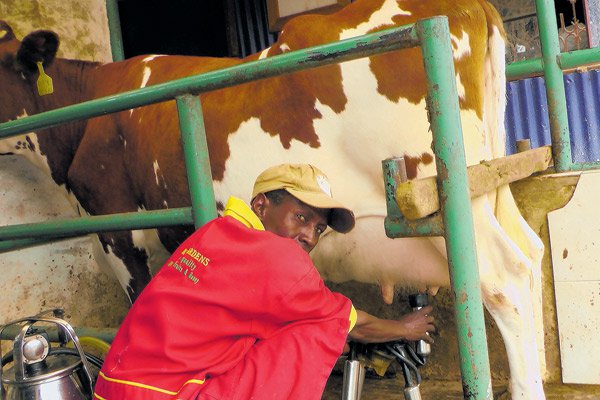How to Feed a Dairy Cow: Many dairy farmers wonder if their cows can perform better than average.
Well, cows increase milk due to improved nutrition, genetic selection, better herd health and general management.
Good nutrition is a requisite of optimal milk production, farmers should aim at balancing diets that encourage the economical, optimal and good composition of milk while maintaining good animal health.
This can only be achieved if we recognise that there is no logical guide to feeding cows, rather understanding their needs to offer the best as guided by the following 10 principles.
1. Analyse feeds for their nutritional composition
Normally, best feeding is delivered when lactating cows are grouped separately into high and low yielders. This makes it easy to know the nutritional requirements of different groups and strategise your feeding. Cows are generally supplemented with concentrates based on production and what roughages offer. If the roughages offered do not meet the threshold nutritive requirement for desired milk production and other maintenance functions, it is evident that the nutrients in short supply have to come from a concentrate mixture.
House prices in most expensive, most affordable estates in Nairobi today
2. Use quality feeds and avoid mouldy roughages
A cow is a factory that utilises quality grass (or other roughage) to give milk. Poor quality, mouldy feeds reduce palatability hence dry matter intake. This in turn leads to a reduced nutrient intake, low weight gain and low milk production.
3. Weigh the amount of feed to include in the total ration
Feed intake for lactating cows is averagely 3 percent of their body weights on dry matter basis. One should know how much parts of each feed (roughage or concentrate) to offer when giving different feed resources to supply different nutrients. This mainly applies in the case of Total Mixed Rations (TMR) or when feeding more than one feed resource. Furthermore, measuring what is actually fed and how much is produced usually helps target optimal feed efficiency. Feed wastage by animals is attributed to not having the idea of what quantity animals need, leading to economic losses.
4. Keep rations constant, especially during the first half of the lactation
After calving, milk production steadily rises up to a peak level. Feeding diets and strategy should aim at steadily increasing milk production and sustaining peak production for as long as possible. Cows that are poorly fed during early phase do not attain peak yield, drop milk production and take longer to return to heat.
5. Observe roughage-concentrate ratio
Allow feeding higher roughage and lower concentrate diets to avoid digestive disorders. This results in lower purchased feed cost per unit of milk produced. While many go for more concentrates for more milk way of feeding, excessive concentrates added rapidly to non-accustomed cows can lead to digestive disturbances resulting to rumen acidosis, loss of appetite, reduced milk production and low milk fat content.
6. Supplement concentrate mixtures with right amount of minerals and vitamins
Minerals make up small portions of diets but have a major functional contribution to dairy animals. Generally they are needed for growth and development of bones, muscle function or formation, water balance and milk production, among others. Vitamins, on the other hand, are needed in minute quantities but are essential for various metabolic processes in the body, ability to fight stress, diseases and to maintain good health. Clearly, they are very important in the diets, therefore finding the right balance for them helps boost overall production.
7. Provide diets that are palatable and appealing to cows
The palatability of a feed can stimulate or inhibit intake. Feed intake provides a framework for a productive and profitable herd. High voluntary feed intake in cows is a good indicator of feed acceptability. Certain feeds like animal by-products and dry, dusty feed are not palatable and reduce intake if included in the diet. Others such as molasses are very palatable and are used to make rations more acceptable and make dry diets softer.
8. Use feeds that do not affect the milk flavour and are beneficial to the animal
High quality, pleasant tasting milk cannot come from unhealthy cows. Keeping cows healthy, therefore, is the first step towards producing tasty milk. Healthy cows with low somatic cell count do not produce milk with a foul aftertaste, off-flavours or unpleasant odours. Some feeds with flavour substances accumulate in cow body tissues, particularly in the fat and later transfer to the blood, hence to the milk. In dairy, avoid feeds that impart undesirable flavour on milk or withhold feeding them for a reasonable amount of time before milking.
9. Purchase right feeds at low costs all the time
The basis of a profitable dairy farming lies in its economic operations. Feeding accounts for a larger percentage of production and a farm may not be able to produce everything a cow feeds on every day. Hence, periodically assess the economic value of feeds being purchased while preserving the value of your herd’s nutritional needs.
10. Optimise diets for profitable dairy business
Always ensure economic competitiveness of your feeding programme. The best way of spending less on feeds is to grow your own fodder. Sometimes if milk production is not optimised with your own feeds, it makes sense to compare the economics of home feed production with outright purchasing of complete concentrates or fodder. The basic principle in dairy farming is ‘no food, no milk’. With good nutrition, dairy cows not only demonstrate their full genetic potential for milk production, but meet the nutritional requirements for maintenance, growth and reproduction.

